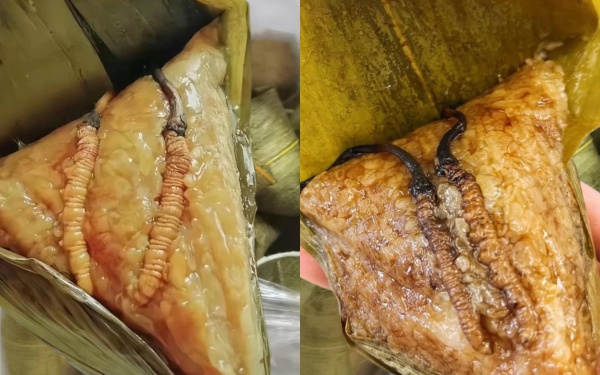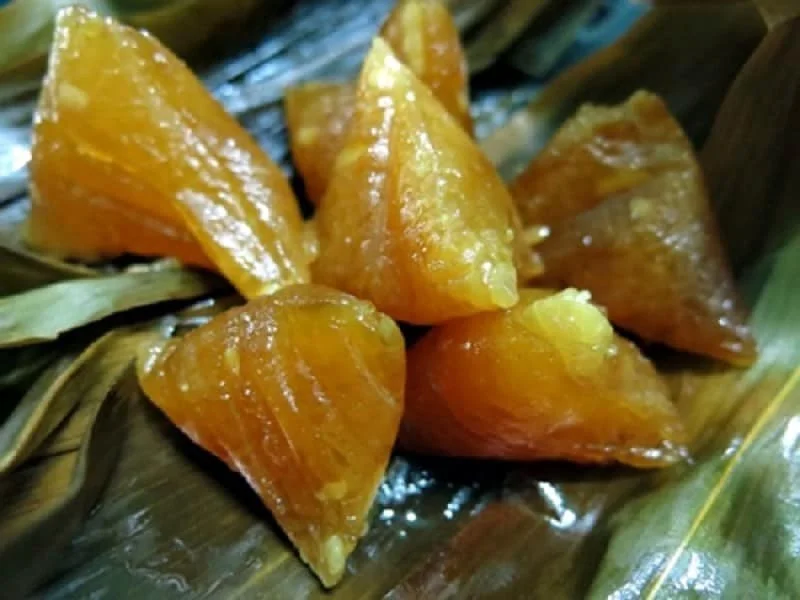Banh tro, also known as ash cake or banh gio, is a unique Vietnamese delicacy enjoyed especially during the Doan Ngo Festival on the 5th day of the 5th lunar month. Originating from Guangdong, China, this treat has been adapted to suit Vietnamese tastes, typically made without fillings and paired with a sweet molasses dip. The process may seem simple, but its flavors and texture make it a cherished traditional dish. Here’s everything you need to know to make banh tro at home.
Ingredients for Ash Cake (Banh Tro)

To make 25 pieces of this delicious ash cake, you will need:
- 500 grams of yellow glutinous rice
- 500 ml of ash water (available in local markets or online)
- Dong leaves (bamboo or banana leaves are suitable alternatives)
- Molasses for dipping
- A pinch of salt
- String for tying
Step 1: Preparing and Soaking the Rice
The first step in making banh tro is preparing the glutinous rice, which needs to be soaked in ash water for optimal texture and color.
- Rinse the rice thoroughly to remove any impurities.
- Prepare the soaking solution by combining 1 liter of water with 500 ml of ash water.
- Place the rice in the solution, allowing it to soak for approximately 22 hours. During this time, occasionally squeeze the rice grains to check for readiness; if the grains start to break easily, the soaking is complete.
- Rinse the soaked rice with clean water several times, then drain it in a basket. Add a small pinch of salt and gently mix, which will enhance the cake’s flavor when cooked.
The soaking process gives banh tro its soft, chewy texture and distinctive amber color, which is achieved through the alkaline properties of ash water.
Step 2: Preparing the Leaves for Wrapping
Traditionally, banh tro is wrapped in dong leaves, but bamboo or banana leaves work just as well.
- Clean and dry the leaves thoroughly.
- Trim off any stems or thick veins to make the leaves more flexible and easier to wrap without breaking.
The leaf wrapping gives banh tro its shape and subtly infuses it with an earthy aroma, adding to the sensory experience.
Step 3: Wrapping the Cakes
Now comes the wrapping, which not only shapes the cakes but also helps keep them intact during the boiling process.
- Lay a leaf flat on a clean surface and place a thin layer of soaked rice on top. A layer about two fingers thick is sufficient.
- Fold the edges of the leaves together carefully, creating a square or triangular shape. Fold the ends tightly and secure the cake with string to ensure it stays intact during boiling.
Note: Because these cakes are small and lightweight, they may float during cooking. To prevent this, place a heavy object on top to keep them submerged, ensuring even cooking.
Step 4: Boiling the Cakes
Once the cakes are wrapped, they’re ready for boiling.
- Fill a large pot with water and add the wrapped cakes. Keep the water level high enough to cover the cakes fully, adding extra boiling water as needed during the cooking process.
- Boil the cakes for 2-3 hours, making sure they stay fully submerged. The long cooking time allows the rice to become translucent and develop its distinct, slightly chewy texture.

Step 5: Preparing the Molasses Dip
Molasses is the traditional dipping sauce for banh tro, offering a sweet contrast to the cake’s subtle flavor. If you don’t have molasses on hand, it’s easy to make your own.
- Place a pan on medium heat and add white sugar.
- Stir continuously as the sugar melts into a thick, amber-colored syrup. Once the sugar has fully dissolved, reduce the heat and let it thicken further.
This homemade molasses will add a rich sweetness to banh tro, enhancing its delicate flavors and providing a delicious contrast.
The Final Product: Enjoying Traditional Banh Tro
After boiling, your banh tro will have a soft, translucent appearance and a slightly chewy texture. The dong or banana leaf wrapping gives the cakes a pleasant, subtle aroma, making each bite a blend of flavors and textures. When dipped in molasses, the cake absorbs the sweet syrup, balancing the mild, earthy taste with a hint of sweetness.
The Cultural Significance of Banh Tro
Banh tro is more than just a treat; it holds cultural significance, especially during the Doan Ngo Festival in Vietnam. Traditionally, the alkaline nature of the cake is believed to aid in digestion and cleanse the body. The festival, often called the “Killing the Insects” festival, focuses on purging the body of unwanted “pests” that accumulate over time, and the consumption of banh tro aligns with this idea of internal cleansing.
The simplicity of banh tro—made from only rice, ash water, and leaves—reflects a minimalistic culinary approach that emphasizes natural ingredients and traditional preparation methods.

Variations of Ash Cake in Other Cultures
While banh tro has become a beloved Vietnamese treat, similar ash-based cakes appear in other cultures, particularly in China. In its origin country, ash cake often includes either sweet or savory fillings, such as mung bean or red bean paste. When the cake made its way to Vietnam, it was simplified to suit local tastes, focusing on the natural flavor of the glutinous rice and using molasses as a dip rather than adding fillings.
Tips for Making the Perfect Banh Tro
To ensure your banh tro turns out just right, keep these tips in mind:
- Choose quality glutinous rice for a better texture. Yellow sticky rice is ideal for this recipe, as it soaks up the ash water perfectly.
- Be patient with the soaking and boiling process. Skipping or shortening these steps will affect the texture and taste.
- Use fresh, clean leaves for wrapping. The quality of the leaves affects the flavor and aroma, as well as the overall appearance of the cakes.
- Make extra molasses if you love a sweeter taste! This simple syrup complements the cake beautifully, and extra dip ensures a sweet treat in every bite.
Conclusion: Banh Tro, A Simple Yet Symbolic Treat
Banh tro is a traditional Vietnamese delight that celebrates simplicity, natural ingredients, and cultural heritage. The process of making these ash cakes—from soaking the rice in ash water to the careful wrapping in dong leaves—pays homage to the customs passed down through generations. The cake’s mild flavor, combined with the sweetness of molasses, creates a unique taste experience that’s both refreshing and satisfying.
Whether you’re enjoying banh tro during the Doan Ngo Festival or simply as a sweet treat, it’s a reminder of the beauty of traditional recipes and the cultural stories they carry. So, next time you’re looking to try a unique dish, embrace the subtle flavors of banh tro and savor this little piece of Vietnamese heritage.


